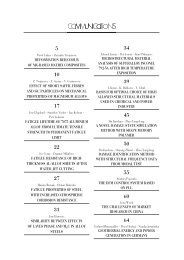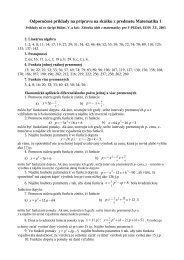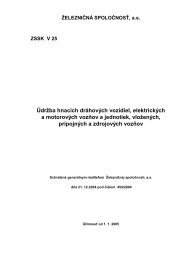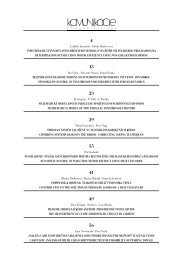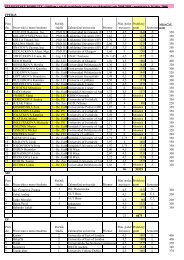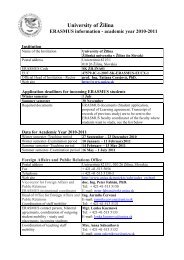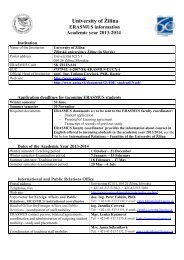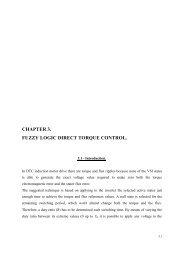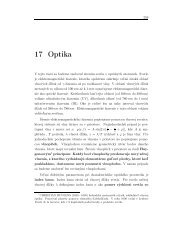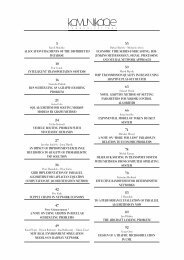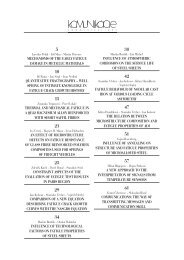simulation of torsion moment at the wheel set of the railway vehicle ...
simulation of torsion moment at the wheel set of the railway vehicle ...
simulation of torsion moment at the wheel set of the railway vehicle ...
You also want an ePaper? Increase the reach of your titles
YUMPU automatically turns print PDFs into web optimized ePapers that Google loves.
2. The simplex algorithm finds a definite optimal solution. On<strong>the</strong> contrary, a genetic algorithm finds a different solution foreach calcul<strong>at</strong>ion. Th<strong>at</strong>’s why a genetic algorithm must be useda number <strong>of</strong> times (<strong>the</strong> more calcul<strong>at</strong>ions <strong>the</strong> higher possibilityto find <strong>the</strong> optimal solution). In <strong>the</strong> next step we analyze<strong>the</strong> best values from <strong>the</strong> genetic algorithm according to o<strong>the</strong>rcriterions because all <strong>the</strong> terms <strong>of</strong> a real system cannot beadded into <strong>the</strong> objective function. Here we can find th<strong>at</strong> <strong>the</strong>best value from <strong>the</strong> genetic algorithm will be unsuitable fora real system and <strong>the</strong> most suitable will be a slightly worsevalue.If we want to solve <strong>the</strong> train route problem we have to definemodel inputs (sort and range <strong>of</strong> values). We used <strong>the</strong> followinginput parameters:● Railroad network – graph (vertices and edges) <strong>of</strong> a real railroadnetwork; vertices are intermodal terminals, edges are tracks(Fig. 3),● Travelling times between vertices,● Train routes – present proposed routes <strong>of</strong> each train accordingto a train oper<strong>at</strong>ion technology,● Stopping time – minimal stopping time <strong>of</strong> a train in node,● Sort <strong>of</strong> pulse – each route has a self pulse between 6 and 24hours,● Reloading time – time needed for reload <strong>of</strong> transport unitsamong trains,● Terminal outputs – volume <strong>of</strong> units reloaded in each node.Fig. 3 Cut <strong>of</strong> Railroad networkFor a <strong>the</strong>oretic model proposal a network from Fig. 3 waschosen. Sixteen nodes (intermodal terminals) and 51 reloadinglinks were added. Distances, travelling times between nodes andpulses were proposed. The pulses are 6, 12 or 24 hours. Thosevalues come up to real pulses for intermodal transports. Reloadingtimes were also valued (from 6 to 10 hours). This time is enoughfor unloading and loading <strong>of</strong> transport units. In Fig. 3 <strong>the</strong>re arealso r<strong>at</strong>ings <strong>of</strong> each reloading link (importance <strong>of</strong> each node).This quantity is stipul<strong>at</strong>ed as a link r<strong>at</strong>ing among each route. Thevalue <strong>of</strong> r<strong>at</strong>ing is a tenth <strong>of</strong> reloaded transport units in TEU(Twenty-foot Equivalent Unit). It means th<strong>at</strong> if we reload 10 TEU,<strong>the</strong> r<strong>at</strong>ing value is 1.Fig. 4 Reloading times and reloading link’s r<strong>at</strong>ings – exampleA very important advantage <strong>of</strong> this model is its variability.This is important especially during individual comput<strong>at</strong>ions andcan without any problems react to some input changes. This <strong>of</strong>fersus <strong>the</strong> possibility to acquire more variable solutions, as describedby Bienstock [2].4.3 The solution resultsThe input d<strong>at</strong>a <strong>of</strong> <strong>the</strong> model were transformed using <strong>the</strong>Premium Solver Pl<strong>at</strong>form Version 7.0 s<strong>of</strong>tware, Frontline Systemsfor Micros<strong>of</strong>t Excel 2007. Based on this product which uses <strong>the</strong>method <strong>of</strong> genetic algorithms, <strong>the</strong> model solution was run inMicros<strong>of</strong>t Excel 2007. For <strong>the</strong> needs <strong>of</strong> finding <strong>the</strong> optimal solutionthis comput<strong>at</strong>ion was run 200 times. The genetic algorithmfinds solutions th<strong>at</strong> cannot be immedi<strong>at</strong>ely classified as optimalones, as described by Debels [5] and Goldberg [9]. Gondro [8]suggests th<strong>at</strong> searching for <strong>the</strong> solution is random and <strong>the</strong>re areusually different results in each comput<strong>at</strong>ion. The optimiz<strong>at</strong>ionwas also carried out several times (<strong>the</strong> more times <strong>the</strong> more probability<strong>of</strong> finding <strong>the</strong> optimal solution). It also seems to be appropri<strong>at</strong>eto choose a few best results and evalu<strong>at</strong>e <strong>the</strong>m followingo<strong>the</strong>r criteria. Because we cannot cover all <strong>the</strong> inputs existing in<strong>the</strong> real world in our objective function it is possible th<strong>at</strong> <strong>the</strong> solutionwith its minimal value can be unsuitable in real life and, on <strong>the</strong>contrary, <strong>the</strong> best usable solution can be a solution with a slightlyworse value <strong>of</strong> <strong>the</strong> objective function. Schmitt [24] and Tuzar[25] found th<strong>at</strong> <strong>the</strong> finding <strong>of</strong> several suboptimal solutions can<strong>the</strong>refore be successfully used.The solution <strong>of</strong> this model can be interpreted ei<strong>the</strong>r in a tableor in a graphic form. The results in a graphic form are expressedas a schem<strong>at</strong>ic represent<strong>at</strong>ion <strong>of</strong> computed results <strong>of</strong> departuresand arrivals <strong>of</strong> <strong>the</strong> trains into nodes in a network graph where <strong>the</strong>vertices are different nodes marked A to P and <strong>the</strong> edges representindividual train connections. Each node was drawn in all <strong>the</strong> relevantconnections with direction and time positions <strong>of</strong> all departuresand arrivals. These time positions are in hours. A value isCOMMUNICATIONS 3/2008 ●23



